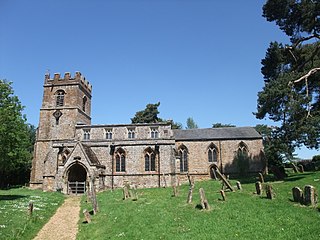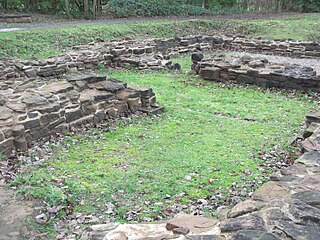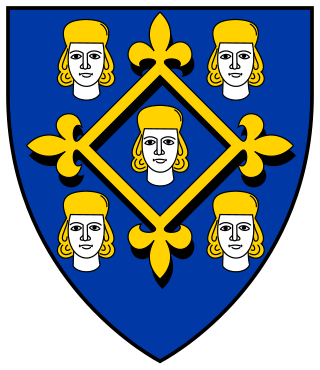James Gairdner was a British historian. He specialised in 15th-century and early Tudor history, and among other tasks edited the Letters and Papers of the Reign of Henry VIII series.
John Sherren Brewer, Jr. was an English clergyman, historian and scholar. He was a brother of E. Cobham Brewer, compiler of Brewer's Dictionary of Phrase & Fable.

Lower Catesby is a hamlet in the civil parish of Catesby, Northamptonshire, about 4 miles (6.4 km) southwest of Daventry. Lower Catesby is beside the nascent River Leam, which rises about 1 mile (1.6 km) to the south in the parish of Hellidon. The Jurassic Way long-distance footpath passes through Lower Catesby. The population of the hamlet is included in the civil parish of Hellidon.

Gregory Cromwell, 1st Baron Cromwell, KB was an English nobleman. He was the only son of the Tudor statesman Thomas Cromwell, 1st Earl of Essex and Elizabeth Wyckes.

Sir William Compton was a soldier and one of the most prominent courtiers during the reign of Henry VIII of England.
The Lisle Papers are the correspondence received in Calais between 1533 and 1540 by Arthur Plantagenet, 1st Viscount Lisle (c.1480-1542), Lord Deputy of Calais, an illegitimate son of King Edward IV and an uncle of King Henry VIII, and by his wife, Honor Plantagenet, Viscountess Lisle, from several servants, courtiers, royal officials, friends, children and other relatives. They are an important source of information on domestic life in the Tudor age and of life at the court of Henry VIII.

Chacombe is a village and civil parish in West Northamptonshire, England, about 3 miles (5 km) north-east of Banbury. It is bounded to the west by the River Cherwell, to the north by a tributary and to the south-east by the Banbury–Syresham road. The 2011 Census gave a parish population of 659 and a 2019 estimate 693.
Sir George Blagge was an English courtier, politician, soldier and a minor poet. He was the Member of Parliament for Bedford from 1545 to 1547, and Westminster from 1547 to 1551, during the reign of Edward VI. His trial and condemnation for heresy in 1546 earned him a place in Protestant martyrology. His family surname was frequently rendered Blage by contemporaries, while another variant was Blake.
George Owen (1499–1558), from Oxford and Godstow, Oxfordshire, was an English royal physician and politician.
Catesby Priory was a priory of Cistercian nuns at Lower Catesby, Northamptonshire, England. It was founded in about 1175 and dissolved in 1536.

Sandwell Priory was a small medieval Benedictine monastery, near West Bromwich, then part of Staffordshire, England. It was founded in the late 12th century by a local landowner and was only modestly endowed. It had a fairly turbulent history and suffered considerably from mismanagement. It was dissolved in 1525 at the behest of Cardinal Wolsey – more than a decade before the main Dissolution of the Monasteries under Henry VIII.

Butley Priory, sometimes called Butley Abbey, was a religious house of Canons regular in Butley, Suffolk, dedicated to The Blessed Virgin Mary. It was founded in 1171 by Ranulf de Glanville, Chief Justiciar to King Henry II (1180-1189), and was the sister foundation to Ranulf's house of White canons (Premonstratensians) at Leiston Abbey, a few miles to the north, founded c. 1183. Butley Priory was suppressed in 1538.
Dr Richard Gwent was a senior ecclesiastical jurist, pluralist cleric and administrator through the period of the Dissolution of the Monasteries under Henry VIII. Of south Welsh origins, as a Doctor of both laws in the University of Oxford he rose swiftly to become Dean of the Arches and Archdeacon of London and of Brecon, and later of Huntingdon. He became an important figure in the operations of Thomas Cromwell, was a witness to Thomas Cranmer's private protestation on becoming Archbishop of Canterbury, and was Cranmer's Commissary and legal draftsman. He was an advocate on behalf of Katherine of Aragon in the proceedings against her, and helped to deliver the decree of annulment against Anne of Cleves.
Letters and Papers of the Reign of Henry VIII is a multi-volume edition of documents from the reign of Henry VIII of England. The series was edited by J. S. Brewer, James Gairdner and R. H. Brodie, and originally published between 1862 and 1932. It remains a key resource for historians of the period, and is now freely available online as part of British History Online.

Henry Man was an English clergyman who served as the Bishop of Sodor and Man in the 16th century.
Sir Ralph Hopton, of Witham, Somerset, was an English courtier and politician. He was the son of a member of the Hopton family and Agnes Haines.

Sir James Leyburn, also Laybourne, Labourn, etc., was a senior representative of one of the powerful families within the Barony of Kendal. He was at different times a Justice of the Peace for Westmorland, Escheator for Cumberland and Westmorland, and Commissioner for the survey of the monasteries of Lancashire. He was caught up in the troubles at Kendal during the Pilgrimage of Grace (1536-1537). As an assistant to Sir Thomas Wharton, Deputy Warden of the West March, he took an important part in the Battle of Solway Moss (1542). He was one of the two MPs for Westmorland in 1542 and 1545.
Sir Arthur Hopton of Cockfield Hall in Yoxford, Suffolk was an English knight, landowner, magistrate, and Member of Parliament.
Geoffrey Chamber was a legal advocate, an associate and agent of Thomas Cromwell's, and was Surveyor and Receiver-General to the Court of Augmentations at the time of the Dissolution of the Monasteries. He was connected with the discovery of the mechanical contrivances in the Rood of Grace at Boxley Abbey.
William Popley, was an English mercer and land owner, whose association with Thomas Cromwell, enabled him to take advantage of the opportunities presented by the dissolution of the monasteries to secure extensive landed estates.










